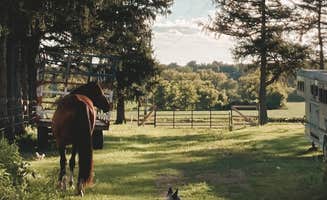Kettle Moraine State Forest offers several horseback riding opportunities near Muskego, Wisconsin. Located in the glacial topography of southeastern Wisconsin, this area features more than 30 miles of bridle trails at elevations ranging from 900 to 1,200 feet. Trail conditions vary seasonally, with spring often bringing muddy sections along the wooded paths and summer providing firmer footing through the forest's mature hardwood stands.
What to do
Trail riding on Ice Age terrain: Access multiple trail networks from Kettle Moraine Southern Unit that showcase Wisconsin's unique glacial formations. "Amazing natural and historical sites. Awesome single-track mountain bike trails. Multiple campgrounds. Something for everyone," notes Bruce G., who appreciates the extensive trail systems.
Seasonal lake activities: Swim or fish at Ottawa Lake during warmer months. "The lake is nice and there is a very nice beach as well as a fishing pier," explains Glenn S., who camped at Kettle Moraine South Camping in the southern unit. Water activities provide an alternative recreation option for non-riding days.
Winter camping options: Experience the forest during colder months when most equestrian campgrounds close. "You can camp year around in this campground. Most recent 2 times were winter camping... No rowdies in winter. Close to hiking. 10 minutes from a town if needed," shares Tim H. about the Ottawa Lake section of Kettle Moraine.
What campers like
Privacy between campsites: Many equestrian campers appreciate the wooded buffers between sites. At Pinewoods Campground, Teresa D. notes: "Was a pretty spacious site with a longer driveway. Lots of Pine, hence the name. There are 3 separate loops, 1 quiet zone, one group, one family."
Well-maintained facilities: Clean bathrooms and showers make multiday trail rides more comfortable. "The bathhouse was very clean," reports Michelle M., who stayed at Fox Den Campground just south of the Wisconsin border. The facilities support extended horseback riding trips.
Diverse terrain for varied riding: Trails range from flat meadows to hilly sections. "We had great hiking weather and some great scenery at the Overlook View," explains Charles M., who enjoyed the varied terrain at Pinewoods. These landscape variations provide different riding experiences within the same forest.
What you should know
Trail conditions change seasonally: Spring can bring mud while summer trails often firm up. "The trails were very well kept up. We had great hiking weather," shares Charles M. from his May trip, though he also noted some maintenance work affecting certain areas.
Reservation requirements: Most equestrian camping requires advance booking, especially during peak season. At Menomonee Park, a county facility closer to Muskego, Matt N. advises: "I would say sites are average size for a county park. All sorts are mostly wooded and offer good shade."
Water access points: Identify where horses can drink along trails. "There are miles of nice hiking trails, a nice beach, pavilions to rent, horse riding trails, archery range and I'm sure I'm missing more," notes Matt N. about Menomonee Park's amenities that support equestrian activities.
Tips for camping with families
Kid-friendly trails: Choose appropriate routes for younger riders. At Mauthe Lake Campground in the northern unit, Kaylyn C. recommends: "Nice beach/swimming area, bike path, and playground for the kids. Also the most beautiful sunset over the lake and pines in July."
Ranger activities: Participate in educational programs when available. "Pick Up the activity book for kids it is a great adventure lots to do at the lake!!!" suggests Jill G. about Mauthe Lake, providing a non-riding option for children.
Quiet loop selection: Request specific camping areas for families needing earlier quiet hours. "We stayed in the quiet loop, Loop 1, which actually was very quiet. Everyone was respectful of the rules," reports Abbe W. about her Pinewoods experience, which can translate well to family equestrian camping.
Tips from RVers
Site selection for trailers: Choose pull-through sites when available with horse trailers. At the Southern Unit Horseriders Campground, Josh F. advises: "There's also a series of pull-through sites that would make it easier for those who don't care to back trailers in or out of the site. These include electric sites 405, 404, 403, 402, and 401."
Electric needs: Consider amperage requirements for larger rigs. At the Horseriders Campground, 50-amp service accommodates larger horse trailers with living quarters, while some nearby campgrounds offer only 30-amp hookups.
Campsite positioning: Select sites away from main roads for horse comfort. "There's a nice couple of campsites at the end of one of the loops that affords a little bit of privacy, the only problem is they abut the main road and are a little noisy with car traffic," cautions Josh F. about sites 427 and 428 at the equestrian campground.


